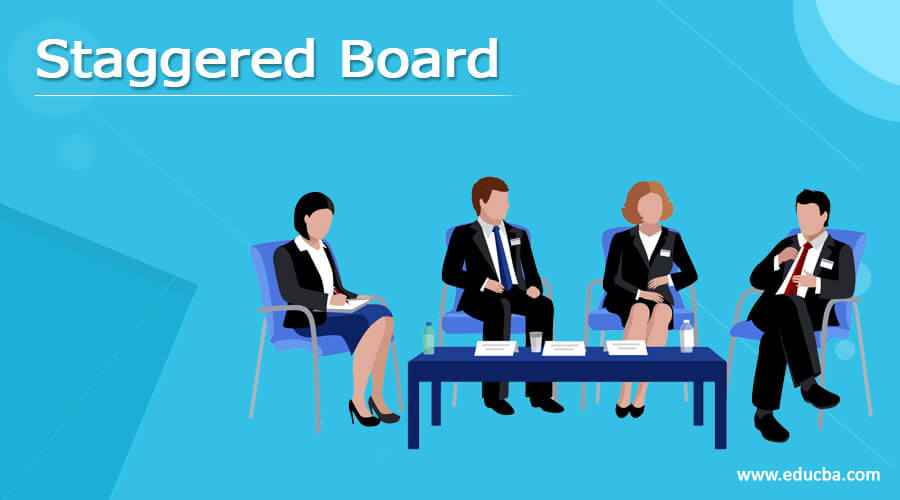Updated July 7, 2023
What is Staggered Board?
The term “staggered board” refers to the arrangement of the board members in such a way that it has members stratified into different classes. In other words, there are multiple classes of directors on the board, and only one has to go through the member election process at any given time.
A staggered board differs from a regular board by electing all board members simultaneously, whereas in a staggered board, the board members are elected at different intervals. People refer to a staggered board as a classified board due to its structure.
Key Takeaways
Some of the key takeaways of the article are:
- A staggered board is a system that stratifies the board members into multiple classes, mainly to prevent hostile takeovers.
- In this, only a particular class of members opens up for the election process at any time.
- It usually consists of classes of members, wherein election for each class takes place in different years.
- Although it is considered helpful against hostile takeovers, the members don’t always act in the best interest of the shareholders.
How Does Staggered Board Work?
Many corporates in the US use the staggered board arrangement for their board of directors. In this arrangement, only a particular group or class of members, instead of the entire board of directors, has to be elected at any given time. The company assigns a particular “class,” such as Class I, Class II, Class III, etc., to each category of members. The underlying principle is that only one class of members will be up for election at any time. Hence the name “staggered.” This system benefits companies that would otherwise be vulnerable to hostile takeovers.
Examples of Staggered Board
Let us take the example of two companies (SDF Inc. and BNM Inc.) to illustrate the significance of a staggered board in the corporate setup. Both companies have 12 members on their boards of directors, each serving for three years. The only difference is that SDF Inc. has a staggered board, while BNM Inc. follows the traditional standard setup for the board of directors.
In SDF Inc., we group the directors into three classes: Class I, Class II, and Class III, each consisting of 4 members. The terms for Class I members are expected to expire by May 2022, while the terms for Class II and Class III members are expected to expire by May 2023. On the other hand, all 12 directors in BNM Inc. have their terms scheduled to expire by May 2022.
Now, let us imagine an adverse situation wherein both SDF Inc. and BNM Inc. are exposed to hostile takeover attempts by their competitors to kill competition and strengthen their market domination. Both companies are trying their level best to overcome the takeover attempts.
The Hostile Takeover of SDF Inc.
To gain control of SDF Inc., the competitor has to garner a majority on the board. However, given that SDF Inc. has a staggered board, the acquirer can only pocket a maximum of 4 members in the election scheduled for May 2022, which is inadequate to achieve a board majority (4 out of 12). So, the acquirer has to wait for the next round of the election to get more board members and achieve a board majority. However, SDF Inc. may devise a plan to somehow overcome the takeover attempt.
The Hostile Takeover of BNM Inc.
Gaining control of BNM Inc. requires the acquirer to secure a majority on the board, which becomes a relatively more straightforward task in this case, considering that BNM Inc. possesses a typical board setup. So, the acquirer can pocket all 12 board members during the election scheduled for May 2022 and quickly complete the takeover.
The above example demonstrates why a staggered board can be a valuable corporate tool to evade such hostile takeover attempts.
Criticisms
Many critics of the staggered board believe that this type of arrangement may run the risk of breeding individuals within the board of directors who may not be willing to work in the best interest of the shareholders in the absence of any adequate external pressure for upholding highest levels of corporate performance.
Advantages
Some of the significant advantages are as follows:
- The members of a staggered board usually enjoy longer tenure, enabling them to focus more on critical business issues.
- The staggered structure of the board provides enough time to devise a strategy to evade abusive or hostile takeover attempts.
- Long-term investors seek steadiness, and a staggered board provides that as the board members are not under much pressure to make any decisions to make dodgy profits.
Disadvantages
Some of the major disadvantages are as follows:
- Offering extended terms to board members, irrespective of corporate performance, may impact a company’s core values.
- In some cases, the staggering change in board members can make it difficult for the board to achieve a majority for a decision.
Conclusion
So, staggering board arrangement is a handy corporate tool that helps prevent hostile takeovers, besides facilitating continuity of leadership. Moreover, if the board members decide to act in the best interest of the shareholders, then a staggered board can be a great value addition to a company.
Recommended Articles
This is a guide to Staggered Board. Here we also discuss the definition, working, examples, and Criticisms, along with advantages and disadvantages. You may also have a look at the following articles to learn more –




